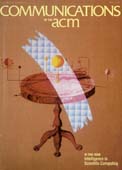May 1989 - Vol. 32 No. 5

Features
Intelligence in scientific computing
The authors discuss the development of intelligent techniques appropriate for the automatic preparation, execution, and control of numerical experiments.
Why the look and feel of software user interfaces should not be protected by copyright law
An attorney looks at how copyright law is applied to the protection of software user interfaces and makes a strong case for reevaluating the way the law views software.
GERTIS: a Dempster-Shafer approach to diagnosing hierarchical hypotheses
Gertis—a prototype expert system—not only demonstrates the feasibility of applying the Dempster-Shafer-based reasoning model to diagnosing hierarchically related hypotheses, but also suggests ways to generate better explanations by using knowledge about the structure of the hypothesis space and knowledge about the intended effects of the rules.
Computer hardware performance: production and cost function analyses
Based on microeconomics, computer hardware performance is analyzed using two methods. For the cost function analysis, both purchase and lease prices are used. The results show no economies of scale for the mainframes and superminis during the 1981-1985 period.
The SEI education program: the challenge of teaching future software engineers
As the technical foundations of software production emerge, software engineers run the risk of obsolescence—now.
An object-oriented requirements specifications method
Analyzing requirements for object-oriented software is examined in an alternative methodology from the more standard structured analysis approach. Through parallel processes of decomposing objects and allocating functions, the methodology is explained in detail.



